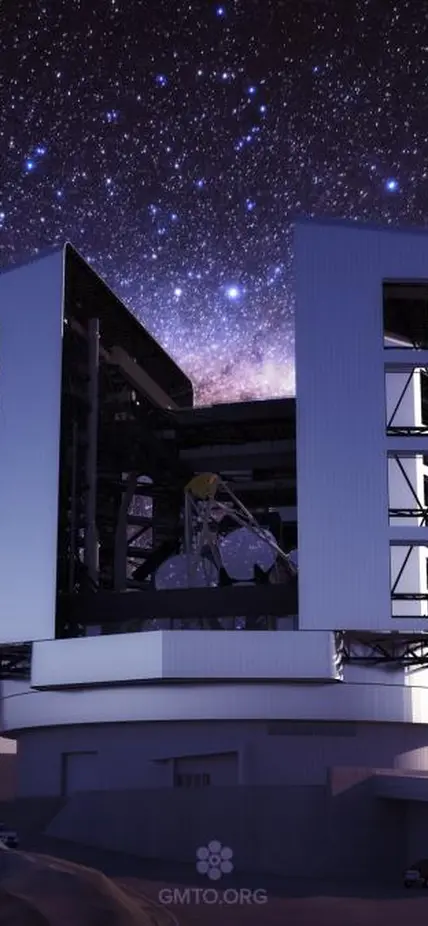Pasadena, CA—A Carnegie-led effort secured $205 million toward the completion of the next-generation Giant Magellan Telescope, which is currently being built at our Las Campanas Observatory in Chile. When completed, the GMT will enable breakthrough astronomy—from revealing the fundamental physics underpinning the cosmos to advancing our ability to search for life on distant worlds.
Last November, the National Academies of Science, Engineering, and Medicine ranked the GMT as a top strategic priority, recommending an injection of federal support to complete its construction and bring about a new era in astronomy. The endorsement was part of the academies’ review of the U.S. Extremely Large Telescope program and other space-related initiatives planned for the next decade.
In recognition of this crucial assessment, Carnegie rallied other project partners to affirm their support with a second infusion of institutional funding. The project awaits word on whether the federal government will follow through on the Academies’ recommendation that completion of an extremely large telescope is “absolutely essential if the United States is to maintain a position as a leader in ground-based astronomy.”
“Six like-minded founders of the Giant Magellan Telescope worked together to help close the financial gap between the resources we have attracted to build the telescope and what is required to complete it,” said Carnegie President Eric Isaacs, who is also Chair of the GMT Founder Representatives. “This investment will bring the telescope closer to our first observations that will provide the world with a transformational understanding of our universe from the formation of the earliest galaxies to the question of life on other planets. Carnegie is proud to have initiated this funding effort and to have worked closely with our peers.”
Carnegie was joined by University of Arizona, the University of Chicago, The University of Texas at Austin, Harvard University, and the São Paulo Research Foundation, which are all founding partners in the initiative to construct the most-powerful telescope ever engineered. Once completed, the GMT will allow astronomers to see farther and with greater detail than ever before possible—thanks to the world’s largest mirrors.
“The public’s tremendous enthusiasm for the James Webb Space Telescope demonstrates that there is a thirst for knowledge about our universe and our place in it—knowledge that GMT can add to in a very significant way,” said Carnegie Science Deputy and Observatories Director John Mulchaey. “The GMT’s capabilities will complement JWST and improve existing ground-based telescopes by leaps and bounds—allowing us to characterize the properties of the ancient stars and galaxies currently being revealed by JWST and to detect biosignatures in exoplanet atmospheres that Webb’s ‘eyes’ can’t see.”
GMT will have ten times the light-collecting area and four-times the spatial resolution of JWST and will be up to 200 times more powerful than any existing ground-based telescopes. Outfitted with special instruments and cameras, it will also give astrophysicists the tools to unravel the mysteries of dark matter, dark energy, black holes, and the origin of our universe.
“We are working with some of the brightest engineers and scientists at the leading research institutions around the globe,” said Walter Massey, GMT Board Chair and former Director of the National Science Foundation. “The recent contributions from our investing partners in the Giant Magellan Telescope are collectively pushing the boundaries of astronomy, making the future a reality, and allowing us to answer some key science goals, including: ‘Are we alone in the universe.’”
The idea for the GMT was born at the Carnegie Observatories and Carnegie has played a crucial role in the GMT’s development since its origin. From the efforts of Carnegie astronomer and GMT Chief Scientist Rebecca Bernstein to the participation of Observatories and Earth and Planets Laboratory scientists in various planning and review phases of the GMT and U.S. ELT program, Carnegie researchers have made major contributions to the telescope’s technical and scientific capabilities. As such, it was fitting for Carnegie to demonstrate its leadership by mustering its fellow founding partners to demonstrate additional financial support toward the revolutionary telescope’s completion.
“We are honored to receive this investment in our future,” said GMT President Robert Shelton. “The funding is truly a collaborative effort from our founders. It will result in the fabrication of the world’s largest mirrors, the giant telescope mount that holds and aligns them, and a science instrument that will allow us to study the chemical evolution of stars and planets like never before.”
